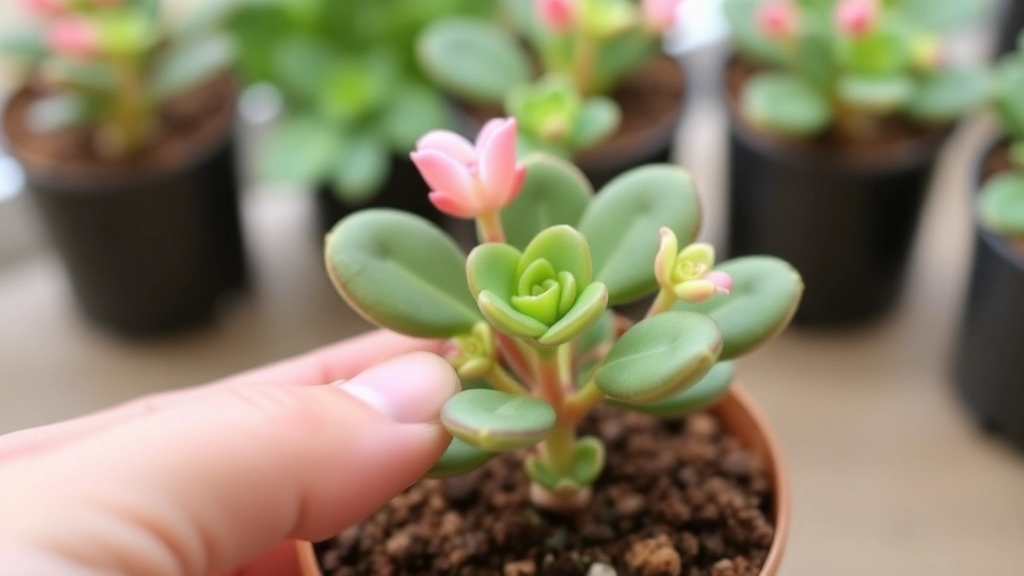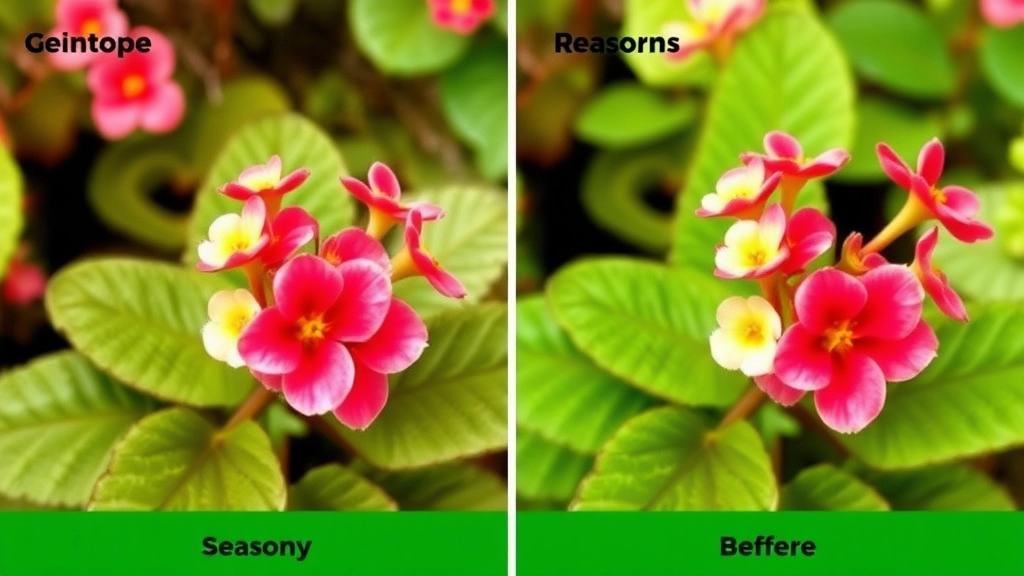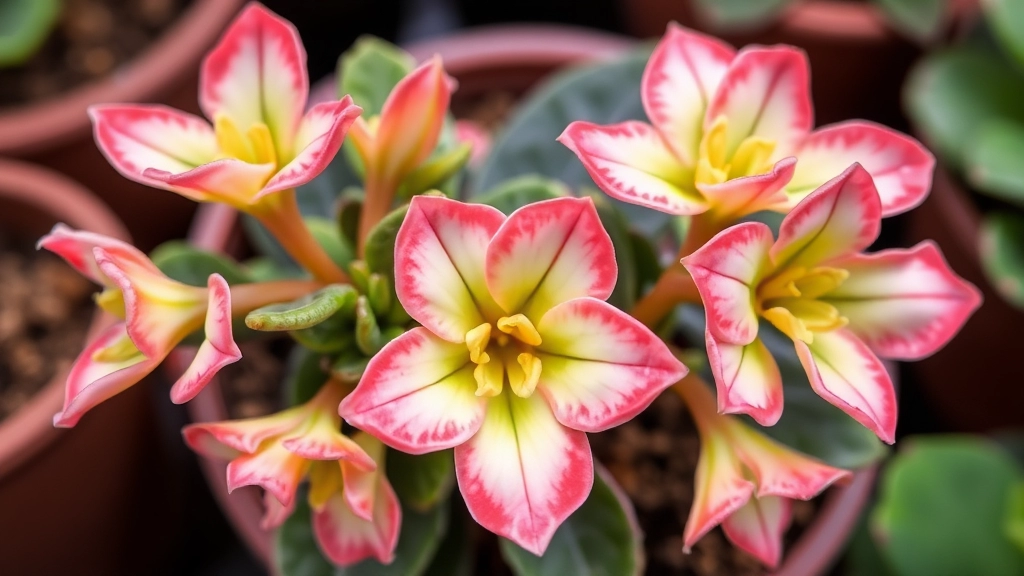Caring for the Kalanchoe Hybrid Little Dragon
When it comes to caring for the Kalanchoe Hybrid Little Dragon, understanding its unique needs is essential. This stunning succulent thrives with minimal water, preferring the soil to dry out completely between waterings. Position it in bright, indirect light to maintain its vibrant red-blushed apple-green leaves. Cooler temperatures can enhance these colours, making your plant even more striking.
Propagation
Propagation of the Kalanchoe Hybrid Little Dragon is straightforward, whether you’re using offsets, cuttings, or seeds. Ensure well-draining soil to prevent root rot and keep an eye out for signs of stress, such as leaf discolouration or wilting. With the right care, your Kalanchoe will flourish, adding a touch of exotic beauty to your indoor garden.
Watering Needs of Kalanchoe ‘Little Dragon’
When caring for your Kalanchoe ‘Little Dragon’, one of the most pressing concerns is its watering needs. Many plant enthusiasts often wonder, “How much water does my Kalanchoe really require?”
Understanding Watering Requirements
Kalanchoe ‘Little Dragon’ is a succulent, which means it stores water in its leaves and stems. This unique trait influences its watering schedule significantly. Here are some essential tips to ensure your plant thrives:
- Frequency: Water your Kalanchoe every 2-3 weeks during the growing season (spring and summer). In winter, reduce watering to once a month.
- Method: Use the soak-and-dry method. Water deeply until it drains from the pot’s bottom, then allow the soil to dry out completely before the next watering.
- Signs of Overwatering: Yellowing leaves or mushy stems indicate too much water. If you notice these signs, cut back on watering immediately.
- Signs of Underwatering: Wrinkled or shrivelling leaves suggest your plant is thirsty. In this case, it’s time to give it a good drink.
By following these simple guidelines, you can ensure that your Kalanchoe ‘Little Dragon’ receives the right amount of moisture it needs to flourish.
Transitioning to Light and Temperature
After getting the watering right, it’s crucial to understand how to get your Kalanchoe to bloom. Ensuring proper light and temperature conditions can significantly impact the health and flowering of your plant. Additionally, if you encounter issues like black spots on your Kalanchoe, knowing how to treat these problems can help keep your plant in optimal condition.
Ideal Light and Temperature Conditions

Are you struggling to keep your Kalanchoe ‘Little Dragon’ thriving? One of the most crucial factors is getting the light and temperature just right.
Light Requirements
Kalanchoe ‘Little Dragon’ loves bright, indirect sunlight. Here’s what you need to know:
- Direct Sunlight: A little is fine, but too much can scorch those lovely leaves.
- Ideal Spot: A south or west-facing window is perfect.
- Low Light: If it’s too dim, your plant might stretch out, looking for more light.
Temperature Preferences
When it comes to temperature, Kalanchoe is pretty chill:
- Optimal Range: Aim for 20-25°C (68-77°F) during the day.
- Nighttime: A slight drop to around 15°C (59°F) is ideal.
- Avoid Extremes: Keep it away from cold drafts and hot air vents.
By ensuring your Kalanchoe ‘Little Dragon’ gets the right light and temperature, you’re setting the stage for a happy, healthy plant.
Soil Requirements and Drainage
When it comes to ensuring the health of your Kalanchoe ‘Little Dragon’, the right soil and drainage are crucial. Many plant owners often worry about overwatering or poor soil conditions that can lead to root rot.
Soil Composition
Kalanchoe ‘Little Dragon’ thrives in well-draining soil. Here are a few key points to consider:
- Cactus Mix: A commercial cactus or succulent mix works wonders. These blends typically contain sand and perlite, which enhance drainage.
- DIY Soil Mix: If you prefer a homemade option, combine equal parts of potting soil, sand, and perlite. This mix will provide the necessary aeration and drainage.
- pH Level: Aim for a slightly acidic to neutral pH (around 6.0 to 7.0) for optimal growth.
Drainage Essentials
Proper drainage is vital to prevent water from sitting at the roots, which can lead to rot. Consider these tips:
Propagation Techniques for Kalanchoe ‘Little Dragon’

Are you eager to expand your collection of Kalanchoe ‘Little Dragon’? Propagation is a rewarding way to do just that. This succulent is not only stunning but also relatively easy to propagate.
1. Leaf Cuttings
- Select a Healthy Leaf: Choose a mature leaf from a healthy plant.
- Make the Cut: Using a clean, sharp knife, cut the leaf at the base.
- Allow to Callous: Place the leaf in a dry, shaded area for a few days to allow the cut end to callous over.
- Planting: Once calloused, place the leaf on well-draining soil and mist lightly. Roots should develop in a few weeks.
2. Stem Cuttings
- Choose a Stem: Look for a healthy stem with a few leaves.
- Cut the Stem: Use a sharp knife to take a cutting about 4-6 inches long.
- Callous the Cut End: Let the cut end dry for a couple of days.
- Planting: Insert the cutting into the soil, ensuring it’s secure. Water sparingly until roots establish.
3. Offsets
- Identify Offsets: Look for small plants growing at the base of the main plant.
- Gently Remove: Carefully separate the offsets from the parent plant, ensuring some roots remain attached.
- Replanting: Place them in their own pots with well-draining soil.
These propagation methods not only help you grow more plants but also allow you to share with friends and family.
Recognizing Stress Signs in the Plant’s Leaves
Understanding how to recognise stress signs in your Kalanchoe ‘Little Dragon’ is crucial for maintaining its health.
Have you ever noticed your plant looking a bit off?
Stress can manifest in various ways, and being able to identify these signs early can save your plant from further decline.
Common Stress Indicators
- Leaf Discoloration
- Yellowing leaves often indicate overwatering or nutrient deficiency.
- Brown tips or edges can suggest underwatering or excessive sun exposure.
- Leaf Dropping
- If your Kalanchoe is shedding leaves, it may be a sign of stress from changes in temperature or humidity.
- Wilting
- Wilting leaves can result from both underwatering and overwatering. It’s essential to check the soil moisture.
- Pale or Stretched Leaves
- This can indicate insufficient light. Your plant may be reaching for more sunlight.
- Pest Infestations
- Look for small spots or webbing on leaves, which may indicate pests like spider mites or aphids.
Recognising these signs early allows you to adjust care practices promptly.
For instance, if you notice yellowing leaves, consider checking your watering schedule. You can refer to our guide on why Kalanchoe leaves turn brown for more insights.
By being proactive, you can ensure your Kalanchoe ‘Little Dragon’ thrives. Additionally, understanding the ultimate guide to caring for Kalanchoe can provide comprehensive tips for overall plant health.
Seasonal Growth and Bloom Patterns of Kalanchoe ‘Little Dragon’

Have you ever wondered when your Kalanchoe ‘Little Dragon’ is going to show its true colours?
Understanding its seasonal growth and bloom patterns can help you nurture it better.
Growth Cycle
- Spring: This is when your plant wakes up from its winter slumber.
- New leaves start to sprout.
- It’s a great time to give it a little extra care.
- Summer: Growth peaks in the warmer months.
- Expect vibrant blooms to appear.
- Keep an eye on watering, as it will need more moisture.
- Autumn: The plant begins to slow down.
- You might notice fewer flowers.
- It’s a good time to reduce watering slightly.
- Winter: This is the dormancy period.
- The plant conserves energy, so growth is minimal.
- Ensure it’s in a cooler spot, but avoid frost.
Bloom Patterns
- Flowering Time: Typically, Kalanchoe ‘Little Dragon’ blooms from late winter to early spring.
- Flower Lifespan: Each bloom can last several weeks, adding colour to your indoor space.
Tips for Encouraging Blooms
- Light: Make sure it gets plenty of bright, indirect light.
- Feeding: A balanced fertiliser during the growing season can boost flowering.
- Pruning: After blooming, trim off dead flowers to encourage new growth.
Common Issues and How to Avoid Them
As we delve deeper into the care of Kalanchoe ‘Little Dragon’, it’s crucial to address the common issues that can arise, ensuring your plant remains healthy and vibrant.
1. Overwatering
One of the most frequent problems is overwatering. Kalanchoes prefer to dry out between waterings.
- Signs: Yellowing leaves and mushy stems.
- Solution: Allow the top inch of soil to dry before watering again.
2. Underwatering
Conversely, underwatering can also be detrimental.
- Signs: Wrinkled, shrivelling leaves.
- Solution: Water thoroughly, ensuring excess drains away.
3. Poor Light Conditions
Kalanchoe ‘Little Dragon’ thrives in bright, indirect light.
- Signs: Leggy growth or fading leaf colour.
- Solution: Position your plant near a window with filtered light.
4. Pest Infestations
Common pests include mealybugs and aphids.
- Signs: Sticky residue on leaves or visible bugs.
- Solution: Use insecticidal soap or neem oil to treat infestations promptly.
5. Temperature Fluctuations
Extreme temperature changes can stress your plant.
- Signs: Drooping leaves or leaf drop.
- Solution: Maintain a stable environment, ideally between 18-24°C (65-75°F).
6. Nutrient Deficiency
Lack of nutrients can lead to poor growth.
- Signs: Stunted growth and discoloured leaves.
- Solution: Feed with a balanced, diluted fertiliser during the growing season.
By recognising these common issues and taking proactive measures, you can ensure your Kalanchoe ‘Little Dragon’ thrives. For more detailed care tips, check out our complete care guide for Kalanchoe Flaming Katy and learn the best tips and techniques for pruning Kalanchoe plants.
Best Companion Plants for Kalanchoe ‘Little Dragon’
So, you’ve got your Kalanchoe ‘Little Dragon’ thriving, and now you’re wondering what plants will play nicely alongside it.
Choosing the right companions can make your plant display pop and even benefit your Kalanchoe.
Here are some fantastic options:
- Aloe Vera: This succulent not only shares similar watering needs but also adds a lovely contrast with its tall, spiky leaves.
- Sedum: With its diverse shapes and colours, Sedum complements the Kalanchoe beautifully, while also thriving in similar light conditions.
- Echeveria: These rosette-shaped succulents are perfect partners. They love bright light and have similar watering habits, making them easy to care for together.
- Haworthia: These small, hardy plants are great if you want to add some texture. They thrive in similar environments and won’t compete for resources.
- Lithops: Also known as “living stones,” these quirky plants can add a fun element to your display. They require minimal water and love bright light, just like your Kalanchoe.
When selecting companions, keep in mind:
- Light Requirements: All these plants enjoy bright, indirect light, just like your Kalanchoe. For more tips on ensuring your Kalanchoe gets the right amount of sunlight, check out our guide on Kalanchoe Full Sun Care Tips.
- Watering Needs: They all prefer to dry out between waterings, so you won’t overwater any of them. Learn more about how to water a Kalanchoe effectively.
- Soil Type: A well-draining soil mix is crucial for all these plants to thrive together.
Frequently Asked Questions about Kalanchoe Hybrid ‘Little Dragon’
What are the ideal light conditions for Kalanchoe ‘Little Dragon’?
Kalanchoe ‘Little Dragon’ thrives in bright, indirect sunlight. A south or west-facing window is ideal. While a little direct sunlight is fine, too much can scorch the leaves. If the light is too dim, the plant may stretch out in search of more light.
What is the optimal temperature range for Kalanchoe ‘Little Dragon’?
The optimal daytime temperature range for Kalanchoe ‘Little Dragon’ is 20-25°C (68-77°F). At night, a slight drop to around 15°C (59°F) is ideal. Avoid exposing the plant to cold drafts and hot air vents to maintain its health.
How can I propagate Kalanchoe ‘Little Dragon’?
There are several methods to propagate Kalanchoe ‘Little Dragon’:
Leaf Cuttings
- Select a Healthy Leaf: Choose a mature leaf from a healthy plant.
- Make the Cut: Use a clean, sharp knife to cut the leaf at the base.
- Allow to Callous: Let the leaf sit in a dry, shaded area for a few days to callous over.
- Planting: Place the calloused leaf on well-draining soil and mist lightly. Roots should develop in a few weeks.
Stem Cuttings
- Choose a Stem: Look for a healthy stem with a few leaves.
- Cut the Stem: Take a cutting about 4-6 inches long with a sharp knife.
- Callous the Cut End: Let the cut end dry for a couple of days.
- Planting: Insert the cutting into the soil and water sparingly until roots establish.
Offsets
- Identify Offsets: Find small plants growing at the base of the main plant.
- Gently Remove: Carefully separate the offsets from the parent plant, ensuring some roots remain attached.
- Replanting: Place the offsets in their own pots with well-draining soil.
What are the seasonal growth and bloom patterns of Kalanchoe ‘Little Dragon’?
Kalanchoe ‘Little Dragon’ has distinct growth and bloom cycles:
Growth Cycle
- Spring: The plant awakens from winter dormancy, and new leaves start to sprout. This is a great time for extra care.
- Summer: Growth peaks, and vibrant blooms appear. The plant needs more moisture during this period.
- Autumn: Growth slows down, and fewer flowers are produced. Reduce watering slightly.
- Winter: The plant enters dormancy, conserving energy with minimal growth. Keep it in a cooler spot but avoid frost.
Bloom Patterns
- Flowering Time: Typically blooms from late winter to early spring.
- Flower Lifespan: Each bloom can last several weeks, adding color to your indoor space.
Tips for Encouraging Blooms
- Light: Ensure it gets plenty of bright, indirect light.
- Feeding: Use a balanced fertilizer during the growing season to boost flowering.
- Pruning: Trim off dead flowers after blooming to encourage new growth.
References
-
Kalanchoe Plant Care
-
How to Grow Kalanchoe Succulents Indoors
-
Kalanchoe Plant – How to Grow Care Guide
